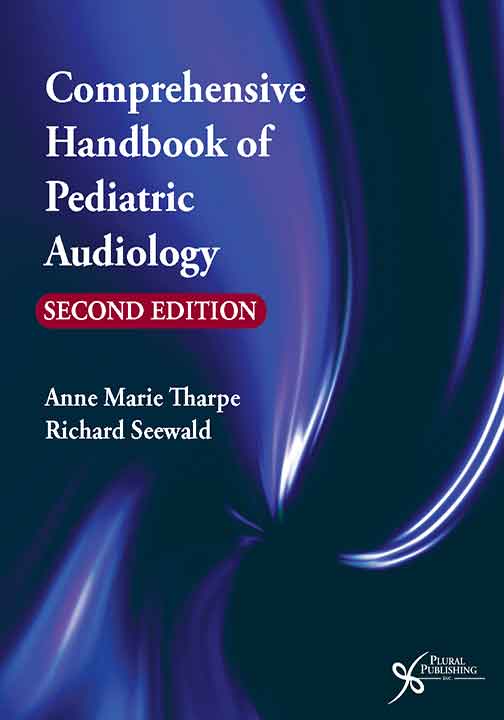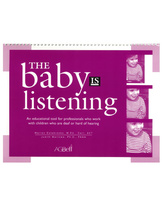
Auditory-Verbal Therapy: Science, Research, and Practice
First Edition
Warren Estabrooks, Helen McCaffrey Morrison, Karen MacIver-Lux
Details: 934 pages, B&W, Hardcover, 7" x 10"
ISBN13: 978-1-63550-174-2
© 2020 | Available
For Instructors
Purchase
Edited by world renown experts with contributions by a global cohort of authors, Auditory-Verbal Therapy: Science, Research, and Practice is highly relevant to today’s community of practitioners of Auditory-Verbal Therapy (LSLS Cert. AVT), and to those who are working towards LSLS Cert. AVT certification. It is also an excellent resource for audiologists, speech-language pathologists, teachers of children who are deaf or hard of hearing, administrators, psychologists, cochlear implant surgeons, primary care physicians, social workers, and other allied health and education professionals. Although written primarily for practitioners, it will be a welcome resource for parents, family members, and other caregivers who love children who are deaf or hard of hearing, and for whom the desired outcomes are listening, spoken language, and literacy.
The book is divided into five parts:
Part I: Overview of Auditory-Verbal Therapy: Foundations and Fundamentals
This section covers the philosophy, history, and principles of AVT, including outcome data, results of a new survey of LSLS Cert. AVT community on global practice patterns in AVT, information on auditory brain development, and evaluation of evidence-based and evidence-informed practice for the new decade.
Part II: Audiology, Hearing Technologies, and Speech Acoustics, and Auditory-Verbal Therapy
This section covers audiology and AVT, hearing aids, implantable and hearing assistive devices, and in-depth speech acoustics for AVT.
Part III: Developmental Domains in Auditory-Verbal Therapy
This section covers the development of listening, three-dimensional conversations, speech, play, cognition, and literacy, as applied to AVT.
Part IV: The Practice of Auditory-Verbal Therapy
Here strategies for developing listening, talking, and thinking in AVT are covered, including parent coaching, the AVT Session: planning, delivery and evaluation, music and singing, assessment, and inclusion of “AVT children” in the regular preschool.
Part V: Extending and Expanding the Practice of Auditory-Verbal Therapy
The final section includes information on children with complex hearing issues, children with additional challenges, multilingualism, children and families experiencing adversity, tele-practice, coaching and mentoring practitioners, and cost-benefit of AVT.
Reviews
“Auditory-Verbal Therapy: Science, Research and Practice provides valuable and updated knowledge on key aspects of the foundations of auditory-verbal-therapy, auditory development, the intervention, and the evidence behind it. Furthermore, the book highlights important discussions of the auditory-verbal approach including how to plan the intervention both in-situ and by tele practise, how to coach parents/caregivers, how to work diagnostically by use of on-going assessment and monitoring of the child’s development. It is appreciated that the book includes discussions of all types of clinical challenges such as children with ANSD, single-sided deafness, soft failure of internal electrodes for children with cochlear implants and not least addresses issues regarding children with additional needs. These areas are important to highlight and discuss as they are understudied in the international literature. This book makes a substantial contribution in a highly warranted area."
—Lone Percy-Smith, PhD, MA, Speech and Language Pathologist, Postdoc Dpt. ORL, H & N Surgery and Audiology, Center for Hearing and Balance, Rigshospitalet, University of Copenhagen
"Together, [this] massive work effectively summarizes auditory-verbal practice, highlights specific challenges to service providers that have hindered access to care for many in the past, and presents valuable solutions and examples. Any clinician or caregiver interested in the latest clinical and academic trends in auditory-verbal therapy should consult this resource."
—Hillary Ganek, PhD, CCC-SLP, LSLS Cert. AVT, Assistant Professor at Western University, in Canadian Audiologist (Vol. 8, Issue 1, 2021)
"Created by three of the world leaders in Auditory-Verbal Therapy (AVT), this book is an expansive and collaborative global effort by expert practitioners in the field of AVT. A voluminous publication, it is a welcome and essential resource for current and aspiring AVT practitioners, as well as for professionals interested in, and associated with the care of deaf and hard of hearing children and their families, who are seeking a listening and spoken language outcome for their child.
By consulting with current practitioners via a global survey, the authors, have obtained up-to-date data about current practices and trends in the AVT field, and what key areas of need are evolving into the future. [...]
Early career AVTs will welcome the comprehensive detailed and holistic coverage of assessment, lesson planning across all developmental domains, whilst experienced clinicians will find invaluable, the final section on extending AVT practice to children and families with additional and complex needs. One of the most valuable topics for clinical practice is how to provide and/or modify AVT treatment plans for children with more complex hearing-related issues (including Auditory Neuropathy Spectrum Disorder (ANSD), Cochlear Nerve Deficiency, Single-Sided Deafness, Cochlear implant device failures and congenital cytomegalovirus (CMV)), as well as for children with additional learning and/ or developmental challenges that traditionally may not been considered as candidates for AVT. [...]
This book is a valuable reference for anyone interested in and/ or involved in the care of children who are deaf or hard-of-hearing, including AVT therapists, allied health professionals, educators and families. It is highly recommended reading to all audiologists, especially those working with paediatric clients."
—Marisa Skok, Cert. AVT, ToD, Audiologist Next Sense, Melbourne, in Audiology Now (Issue 83)
“Auditory-Verbal Therapy: Science, Research, and Practice is a comprehensive collection of chapters that focus on the theory and practice of Auditory-Verbal Therapy (AVT) written by over 40 field experts from across the globe, including deaf authors. Twenty-seven chapters are divided into five sections: (a) fundamentals of AVT, (b) importance of auditory access and hearing technology, (c) development across essential domains in AVT, (d) implementation, and (e) AVT for diverse populations.
The emphasis of this text is on young children (under age 8) who have received early intervention and have optimal auditory access through hearing technology. Chapters include research along with resources and suggestions for development of listening, language, speech, cognition, play, and literacy skills. Strategies, prompts, and reflection questions that practitioners can use when planning intervention, coaching families, and evaluating a child’s progress are also included.
The text is easy to read without diluting the concepts described. This handbook serves as a foundation for starting AVT training with families (particularly Chapters 15 and 17) and to deepen the reader’s understanding of AVT methods. Chapters 9-14 focus on developmental domains and provide a foundation in typical development domains and provide a foundation in typical development intervention for practitioners and families. Tables, charts, and other summaries guide practitioners to reflect on a child’s progress, coach parents, and individualize therapy. The authors encourage users to adapt content to their cultural-linguistic context. Case studies provide a quasi-hands-on experience for the reader to implement theory into practice and are reflective of the changing diversity in children who receive AVT. In short, this handbook provides practicing specialists an overview, but also enough prompts to facilitate reflection on their current practice for personal professional growth. […]
In summary, this text provides in-depth information for meeting the needs of young children in early intervention with resources that support listening and spoken language development and an informative guide for a novice or seasoned practitioner."
—Uma Soman & Stephanie J. Gardiner-Walsh, Carle Auditory Oral School & Illinois State University, in Journal of Deaf Studies and Deaf Education (2021)
“Edited by world-renowned experts such as Warren Estabrooks, Auditory-Verbal Therapy: Science, Research, and Practice is a comprehensive reference manual ranging from the fundamentals of auditory-verbal therapy, through audiology and auditory technologies, developmental domains, to practice and its extension and expansion in auditory-verbal therapy. It is especially suitable for people who are working in LSLS (Listening and Spoken Language Specialist) Cert. AVT, but also for audiologists, therapists, teachers of deaf and hard of hearing children, ICU surgeons, primary care physicians, social workers, and other professionals involved in health and education. Although written primarily for professionals, it is a resource that may also be helpful for parents, family members, and other caregivers of children who are deaf or hard of hearing and for those seeking auditory comprehension, the basics of spoken language domains, and literacy.”
—Integración Magazine, Issue 97 (January 2021)
“[…] the AVT continues to develop along with advances in newborn hearing screening, early interventions, hearing technologies, and scientific research. Any clinician interested in the latest clinical and academic trends in AVT should consult this resource.
[…] Particularly relevant are the chapters with the latest research and findings on rehabilitation of children with unique hearing issues or with additional learning and/or developmental challenges, on multilingualism, and on those who experience adversity (poverty, violence, and family instability). Traditionally those children have not been considered as candidates for AVT.
[…] Auditory-Verbal Therapy. Science, Research, and Practice is suitable to bring current knowledge about AVT not only to practitioners but also to parents. […] The book includes deepening sections, case examples, conversational scenarios, examples of dialogues between children and practitioners (called “snapshot” in the text), and analysis of each developmental stage. […]”
–Anna Agostinelli, University of Padova, in Hearing, Balance, and Communication (December 2021)
Preface
Acknowledgments
Editors
Contributors
About the Cover
Part I. Auditory-Verbal Therapy: Foundations and Fundamentals
Chapter 1. Auditory-Verbal Therapy: An Overview
Warren Estabrooks, Helen McCaffrey Morrison, and Karen MacIver-Lux
Chapter 2. Auditory Brain Development and Auditory-Verbal Therapy
Carol Flexer and Jace Wolfe
Chapter 3. Evaluating the Research and Examining Outcomes of Auditory-Verbal Therapy: Moving from Evidence-Based to Evidence-Informed Practice
Alice Eriks-Brophy, Hillary Ganek, and Glynnis Dubois
Part II. Audiology, Hearing Technologies, Speech Acoustics, and Auditory-Verbal Therapy
Chapter 4. Audiology and Auditory-Verbal Therapy
Carolyne Edwards
Chapter 5. Hearing Aids and Auditory-Verbal Therapy
Ryan W. McCreery and Elizabeth A. Walker
Chapter 6. Implantable Hearing Technologies and Auditory-Verbal Therapy
Sara Neumann and Jace Wolfe
Chapter 7. Hearing Assistance Technologies and Auditory-Verbal Therapy
Sarah E. Warren, Tina Childress, and Olivia G. Naegle
Chapter 8. Speech Acoustics and Auditory-Verbal Therapy
Helen McCaffrey Morrison
Part III. Developmental Domains in Auditory-Verbal Therapy
Chapter 9. Development of Listening and Auditory-Verbal Therapy
Helen McCaffrey Morrison
Chapter 10. Development of Three-Dimensional Conversations and Auditory-Verbal Therapy
Helen McCaffrey Morrison and Warren Estabrooks
Chapter 11. Development of Speech and Auditory-Verbal Therapy
Helen McCaffrey Morrison
Chapter 12. The Development of Play and Auditory-Verbal Therapy
Rosie Quayle, Louise Ashton, and Warren Estabrooks
Chapter 13. The Development of Cognition and Auditory-Verbal Therapy
Frances Clark and Warren Estabooks
Chapter 14. Development of Literacy and Auditory-Verbal Therapy
Lyn Robertson and Denise Wray
Part IV. The Practice of Auditory-Verbal Therapy
Chapter 15. Strategies for Developing Listening, Talking, and Thinking and Auditory-Verbal Therapy
Karen MacIver-Lux, Elaine Smolen, Elizabeth Rosenzweigh, and Warren Estabrooks
Chapter 16. Coaching Parents and Caregivers in Auditory-Verbal Therapy
Karen MacIver-Lux, Warren Estabrooks, and Joanna Smith
Chapter 17. The Auditory-Verbal Session: Planning, Delivery, and Evaluation
Warren Estabrooks, Louise Ashton, Rosie Quayle, Frances Clark, Karen MacIver-Lux, Sally Tannenbaum, Lisa Katz, and Dave Sindrey
Chapter 18. Music and Singing in Auditory-Verbal Therapy
Amy McConkey Robbins
Chapter 19. Assessment in Auditory-Verbal Therapy
Lindsay Zombek
Chapter 20. Children in Early Childhood Classrooms and Auditory-Verbal Therapy
Helen McCaffrey Morrison, Karen MacIver-Lux, Stacey R. Lim, Carrie Norman
Part V. Extending and Expanding the Practice of Auditory-Verbal Therapy
Chapter 21. Children with Unique Hearing Issues and Auditory-Verbal Therapy
Karen MacIver-Lux and Stacey R. Lim
Chapter 22. Children with Additional Challenges and Auditory-Verbal Therapy
Kathryn Ritter, Denyse V. Hayward, Warren Estabrooks, Noel Kenely, and Sarah Hogan
Chapter 23. Multi-lingualism and Auditory-Verbal Therapy
Elizabeth M. Fitzpatrick and Suzanne P. Doucet
Chapter 24. Children Who Are Deaf or Hard of Hearing and Families Experiencing Adversity: The Role of the Auditory-Verbal Practitioner
Jenna Voss and Susan Lenihan
Chapter 25. Telepractice and Auditory-Verbal Therapy
Emma Rushbrooke, Monique Waite, and K. Todd Houston
Chapter 26. Coaching and Mentoring Practitioners and Auditory-Verbal Therapy
Helen McCaffrey Morrison and Cheryl L. Dickson
Chapter 27. Cost Benefit of Auditory-Verbal Therapy
Anita Grover, Ellie Goldblatt, and Sarah Hogan
Afterword
Index

Cochlear Implants: Audiologic Management and Considerations for Implantable Hearing Devices
First Edition
Jace Wolfe
Details: 858 pages, Full Color, Hardcover, 8.5" x 11"
ISBN13: 978-1-59756-892-0
© 2020 | Available

Auditory-Verbal Therapy: For Young Children with Hearing Loss and Their Families, and the Practitioners Who Guide Them
First Edition
Warren Estabrooks, Karen MacIver-Lux, Ellen A. Rhoades
Details: 602 pages, B&W, Hardcover, 7" x 10"
ISBN13: 978-1-59756-888-3
© 2016 | Available

Comprehensive Handbook of Pediatric Audiology
Second Edition
Anne Marie Tharpe, Richard Seewald
Details: 1003 pages, B&W, Hardcover, 8.5" x 11"
ISBN13: 978-1-59756-615-5
© 2017 | Available

Assessing Listening and Spoken Language in Children with Hearing Loss
First Edition
Tamala S. Bradham, K. Todd Houston
Details: 496 pages, B&W, Softcover, 7" x 10"
ISBN13: 978-1-59756-576-9
© 2015 | Available

Listen to This: An Auditory-Verbal Therapy Videotape and Guidebook for Professionals and Parents, Volume 1
First Edition
Warren Estabrooks, Karen MacIver-Lux, Lisa Katz, Maria Emilia De Melo
Details: 76 pages, B&W, Softcover + DVD, 5.5" x 8.5"
ISBN13: 978-0-88202-220-0
© 2004 | Available

Listen to This: An Auditory-Verbal Therapy DVD and Guidebook for Professionals and Parents, Volume 2
First Edition
Warren Estabrooks, Karen MacIver-Lux, Lisa Katz, Maria Emilia De Melo
Details: 118 pages,B&W, Softcover + DVD, 5.5" x 8.5"
ISBN13: 978-0-88200-224-8
© 2006 | Available

Songs for Listening! Songs for Life!
First Edition
Warren Estabrooks, Lois Berkshaw-Fleming
Details: 238 pages, 2-Color, Spiral Bound + CD, 8.5" x 11"
ISBN13: 978-0-88200-214-9
© 2003 | Available

Hear and Listen! Talk and Sing! Songs for Young Children Who Are Deaf or Hard of Hearing and Others Who Need Help Learning to Talk
First Edition
Warren Estabrooks, Lois Berkshaw-Fleming
Details: 127 pages, B&W, Spiral Bound + CD, 8.5" x 11"
ISBN13: 978-0-88200-218-7
© 2006 | Available

We Learned to Listen
First Edition
Warren Estabrooks
Details: B&W, Softcover, 6" x 9"
ISBN13: 978-0-88200-222-4
© 2005 | Available

The Baby Is Listening: An Educational Tool for Professionals Who Work with Children Who Are Deaf or Hard of Hearing
First Edition
Warren Estabrooks, Judith Marlowe
Details: 78 pages, B&W, Spiral Bound + DVD, 8.5" x 11"
ISBN13: 978-0-88200-211-8
© 2000 | Available

Children with Hearing Loss: Developing Listening and Talking, Birth to Six
Fourth Edition
Elizabeth B. Cole, Carol Flexer
Details: 411 pages, B&W, Softcover, 7" x 10"
ISBN13: 978-1-63550-154-4
© 2020 | Available

Deaf Culture: Exploring Deaf Communities in the United States
Second Edition
Irene W. Leigh, Jean F. Andrews, Raychelle L. Harris, Topher González Ávila
Details: 384 pages, B&W, Softcover, 7" x 10"
ISBN13: 978-1-63550-173-5
© 2022 | Available

Listening and Spoken Language Therapy for Children With Hearing Loss: A Practical Auditory-Based Guide
First Edition
Sylvia Rotfleisch, Maura Martindale
Details: 310 pages, Full Color, Softcover, 7" x 10"
ISBN13: 978-1-63550-387-6
© 2023 | Available

Foundations of Aural Rehabilitation: Children, Adults, and Their Family Members
Sixth Edition
Nancy Tye-Murray
Details: 567 pages, 2-Color, Softcover, 8.5" x 11"
ISBN13: 978-1-63550-420-0
© 2024 | Available



